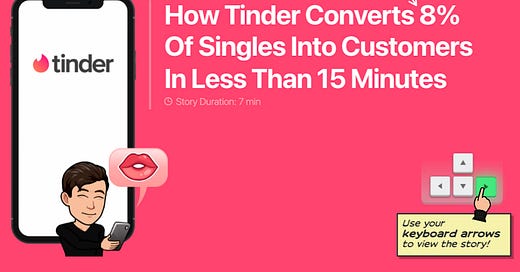Here’s what we have for you this week.
-
Growth
💻 Tools: Enhance your Logo and Save time.
🧠 Persuasion: Be more Progressive.
📰 Article: 18 Mistakes to Avoid.
🤖 Automation: Tasks from Note-Taking.
Product
💻 Tools: Find your first clients.
🧠 Persuasion: Don’t overthink!
📰 Article: The 7-step experimentation framework.
💰 My 2 cents: Product and Sales teams could be friends.
Growth.
Tools 👇
Krea.AI → Turn your logo into awesome visualizations. (free)
Upload logo, write prompt, voila.
-
PhantomBuster → Scrape the web, and automate lead generation, on almost every platform. (free trial)
One of the best tools on the market, period.
Also has amazing customer support.
Persuasion Technique 👇
Don’t rush it.
Progressive Disclosure: Users are less overwhelmed if they're exposed to complex features later. 🧠
A great example of this is Tinder, just took a look at this use case.
Article 👇
Failing is learning, but not always.
The 18 Mistakes that Kill Startups.
This article is quite extensive, let us give you the big lines.
Single Founder: Startups rarely succeed with just one founder. Multiple founders bring diverse perspectives and emotional support.
Bad Location: Startups thrive in certain locations where resources, expertise, and support systems are abundant.
Marginal Niche: Choosing a small, obscure niche to avoid competition often leads to failure.
Derivative Idea: Successful startups usually originate from unique ideas, not imitations of existing businesses.
Obstinacy: Flexibility is crucial in startups. Sticking rigidly to an initial plan can be detrimental.
Hiring Bad Programmers: The quality of programmers can make or break a tech startup.
Choosing the Wrong Platform: The choice of technology platform can significantly impact the startup's future.
Slowness in Launching: Delaying a launch can be harmful. It's important to release a product to users for feedback and improvement.
Launching Too Early: Launching a product that's not ready can damage a startup's reputation.
Having No Specific User in Mind: Understanding the target user is essential for creating a product they'll love.
Raising Too Little Money: Underfunding can prevent a startup from reaching significant milestones.
Spending Too Much: Overspending can deplete resources and lead to failure.
Raising Too Much Money: Excessive funding can lead to loss of focus and increased pressure.
Poor Investor Management: Balancing input from investors with the founders' vision is critical.
Sacrificing Users to (Supposed) Profit: Prioritizing profit over user needs can be counterproductive.
Not Wanting to Get Your Hands Dirty: Founders need to be involved in all aspects of the business, not just product development.
Fights Between Founders: Founder conflicts can derail a startup.
A Half-Hearted Effort: Startups require full commitment. Part-time efforts rarely lead to success.
Here is the article, read it!
Automation 👇
Are you a note-taker?
Then there are multiple ways to automatically transform your notes into tasks.
Zapier has a great article on how to.
Pick the tools you use, and save yourself some time.
Product.
Tool 👇
AppSumo → A platform to find deals on new tools but also to test your product😉
With their AppSumo Select program, you can
Find your first clients.
Collect real feedback from their target audiences: entrepreneurs, small business owners, marketers, and freelancers.
Ask them questions about the features they would like to have in the next release of your tool.
Saas Mantra → You can do it twice using this other platform.
The differences?
Saas Mantra is more focused on Saas Solution. On AppSumo, you can also find courses, eBooks, and other digital solutions. AppSumo is the oldest one, so the community is huge!
Oh, and Lemlist was launched on AppSumo. ;)
Persuasion Technique👇
Have you ever heard of the Jam Study?
Two psychologists, Sheena Iyengar and Mark Lepper, conducted this study at a local food market in 2000.
On day one, people would find a table with 24 kinds of jams.
On day two, the table shows only 6 kinds of jams.
Guess which display table leads to more sales?
The one with only 6 kinds of jams.
Consumers were ten times more likely to purchase jams in this situation.
Hick’s Law - “The time it takes to make a decision increases with the number and complexity of choices. ” 🧠
Article 👇
Experimentation is crucial for product teams, but there are many ways to do it wrong.
It's not about making guesses; it's about making smart, informed decisions that align perfectly with your business growth and customers' needs.
Last week, we discussed the importance of a clear and straightforward prioritization process.
Now, let’s dig into that with this article from Amplitude.
The first part of the article is about why you need this. I leave you to it and jump directly into :
The “7-step experimentation framework”.
1. Define a growth lever
Identify a critical area (like acquisition, retention, or monetization) that aligns with your business's growth objectives.
⚡️Example: “Accelerating acquisition is our priority, and our highest-trafficked landing page (the homepage) is underperforming.”
2. Define the customer problem
Understand and articulate the problem from the customer's perspective.
⚡️ Example: “Customers are confused about our value proposition.”
3. Develop a hypothesis
Based on your current understanding, formulate a theory explaining why this customer problem exists.
⚡️ Examples: “Customers are confused due to poor messaging.” or “Our page has too many action buttons.”
4. Ideate possible solutions with KPIs
Brainstorm potential solutions and determine the key performance indicators (KPIs) for measuring their success.
⚡️ Example: “Solution: Iterate on the copy. - KPI: Improve the visitor conversion rate”
5. Prioritize solutions
Evaluate and rank the proposed solutions based on their implementation cost, potential business impact, and your confidence in their effectiveness.
⚡️ Our suggestion: Let’s use a prioritization framework like Reach Impact Confident Effort (RICE).
6. Create an experiment statement and run your tests
Compile all the previous steps into a clear experiment statement and then conduct your tests.
⚡️ Example: “Accelerating acquisition is our priority, and our highest trafficked landing page—the homepage—is underperforming [growth lever] because our customers are confused about our value prop [customer problem] due to poor messaging [hypothesis], so we will iterate on the copy [solution] to improve the visitor conversion rate [KPI].”
7. Learn from the results and iterate
Analyze the outcomes of your experiments, update your understanding of the customer problem and hypothesis, and continue iterating.
Elena Verna wrote the article, and that’s all you have to know to read it!
This is the link.
My 2 cents 👇
In the SaaS industry, companies have developed and adopted various growth models to drive their business success.
Let’s talk about the main ones :
Product-led growth (PLG): characterized by using the product as the primary driver of customer acquisition, conversion, and expansion.
The product is designed to be inherently shareable and to encourage viral growth.Sales-Led Growth (SLG): Unlike product-led growth, it relies heavily on a sales team to drive customer acquisition and expansion. This model is expected in enterprise SaaS, where products are complex and high-touch sales processes are required.
There is also: Community-Led Growth, Service-Led Growth, Marketing-Led Growth…
The one we are interested in these days is Product-Led Sales.
It’s a combination of PLG and SLG.
This approach recognizes that while a product can drive significant user acquisition and growth, sales teams have a crucial role.
Here's a breakdown of how Product-Led Sales works:
Your product attracts people and converts them with a first step: free trials / freemium models / interactive demos. (🧠 foot-in-the-door technique)
Your product proposes a great onboarding to help people reach the wow effect in self-serve mode.
Your product identifies high-profile users or upsell opportunities.
Your sales team focuses on these users.
This approach relies heavily on:
The product is valuable enough to attract and convert users.
The data stack and user behavior analytics are perfectly executed.
The sales team is involved in consulting, understanding customer needs, and helping them get the most value from the product.
Ideal Scenarios for Product-Led Sales :
Complex Products: users need additional guidance to understand the total value or capabilities of the product for their company.
Enterprise Sales: Larger clients often require a more traditional sales approach, even if the product initially attracted them.
This model is efficient, Scalable, customer-centric, and data-driven.
We’ll see you next week.












